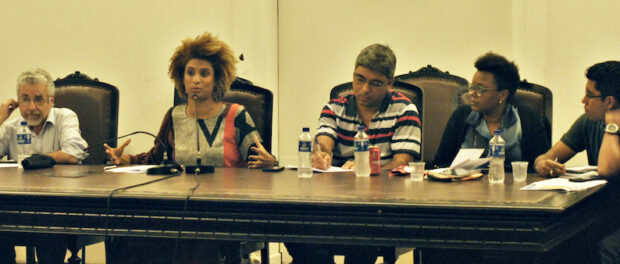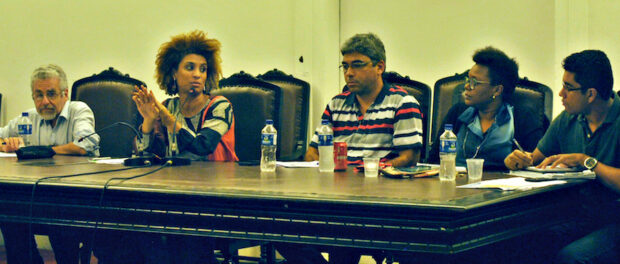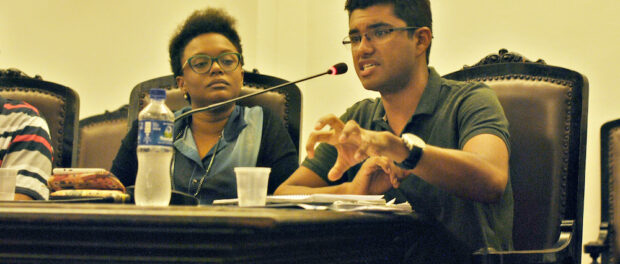
A series of public forums on the metropolis of Rio de Janeiro continued on October 23 with its second installment, titled “Rio’s Strategic Plan: Urban Entrepreneurship and the Institutional Fragmentation of the Metropolis.” The event was organized by the Comitê Popular de Luta (Popular Committee of Struggle) and the Observatório das Metrópoles (Metropolis Observatory), and took place at the Federal University of Rio de Janeiro’s Institute of Philosophy and Social Sciences (IFCS/UFRJ).
To debate Mayor Marcelo Crivella’s Strategic Plan, the organizers invited Tainá de Paula of the decades-old and highly respected Bento Rubião Foundation housing development and advocacy organization, City Councillor from the Maré favela Marielle Franco, Henrique Silveira of Casa Fluminense regionally-focused think-tank and advocacy group, and Adauto Cardoso of the Metropolis Observatory to discuss the Plan’s goals, with a particular emphasis on those relating to housing rights and the right to the city.
The panelists’ main objections to the Strategic Plan focused on the lack of specificity in the goals, the lack of public participation and dialogue, and the City’s reliance on funding from Urban Operations Consortia and Public Private Partnerships (PPPs) in order to implement housing programs.
Adauto Cardoso, who monitors and evaluates the city’s urban public policies, argued that the Plan is extremely generic, with few details or justifications: “It doesn’t include a diagnosis. And if you have a plan without a diagnosis, how can you assess what the problems are? How can you decide if a given goal is appropriate? Or what the impact is of a given goal on the program, or on a specific problem?” He suggested the lack of specific information makes it impossible to really measure the quality of the Plan and its impacts. Furthermore, Tainá de Paula pointed out that the Plan also lacks details about how the goals will be financially viable, arguing that some are very ambitious given the current economic situation.
In his analysis of the multi-year plan, Cardoso noted that the financial viability of the goals related to housing will depend on federal funding through programs such as the Minha Casa Minha Vida (MCMV) public housing program, the Growth Acceleration Program (PAC), and the Public Settlements Program (PROAP III). In his view, basing housing policy on federal funding, without allocating municipal funding, is a big problem as it is unclear for how long federal resources will remain available.
The Plan outlines a number of housing policy proposals, including upgrading projects in 21 favelas by 2020 (goal #73); the urban redevelopment of the Rio das Pedras favela (goal #74); land titling for 100,000 households by 2020 (goal #75); 20,000 Social Interest Housing units by December 2020 (goal #77); the implementation of the Mais Moradias (More Housing) program, which provides for the construction of housing for families that earn up to the equivalent of 10 minimum wages via MCMV; and the removal of 14,204 homes in the Tijuca Massif area due to geological-geotechnical risks (goal #76)—raising the debate around the environmental risk discourse in the context of forced evictions. The forum participants raised concerns about the form in which these projects would be implemented, and also questioned where the resources would come from since the Plan does not provide specific details on funding and instead appears to rely on federal government funding.
Cardoso explained: “One thing that appeared in the Plan was the idea to implement upgrading projects in 21 favelas by 2020, or, in the next three years. An ambitious goal. When we looked closely at this goal, we realized that the funding for these goals was coming from resources allocated to PAC and PROAP III. PROAP III is the successor of the Favela-Bairro upgrading program which has resources still to spend, and therefore it’s a continuation of construction work that was already in progress. Because of the fluctuation of the dollar, there are still some resources remaining, so they’re being invested in a new project. PAC is also a federally funded program. The Plan doesn’t contain any funding allocated from the City itself.” He noted that this is the first time the City has not made a single new proposal for favela upgrades since 1993.
Cardoso also highlighted that the Mais Moradias program intends to build housing units on a parcel of land owned by General Electric in the favela of Jacarezinho, which is another cause for concern because the cost of decontaminating this land would be enormous.
Even the plan for Rio das Pedras, a part of the “Integrated Territories” program, only specified the objective “to conclude the studies on urban requalification in Rio das Pedras by 2018.” Yet the City already announced its intention to verticalize the area by building 100 apartment buildings—each with up to 12 floors—sparking mass mobilization among local residents and eventually leading the City to backtrack on its proposal. The planned project diverged from what should be done: favela upgrades should respect the local built environment as much as possible, avoid forced removals, and implement development projects according to the needs of local residents as expressed through participatory dialogues. Despite the lack of transparency around the plans and the lack of resident participation in the development of proposals for this region, Cardoso mentioned some construction companies had already expressed interest in the project.
The researcher further observed that “there is a consistent pattern of relying on Public Private Partnerships and Urban Operations Consortia as the main strategy to generate financial resources. When we look at these Urban Operations Consortia, the two that are cited are the Central Station and Rio das Pedras.” The Urban Operations Consortium related to Rio’s Central Station is tied to Strategic Plan goal #67, which intends to “launch the call for Expressions of Interest in the Presidente Vargas Urban Operations in 2017” and promote local urban restructuring through the “Centralidades Cariocas” program.
Cardoso asked: “You still have a lot of space to build in the Port region and you’re going to launch another project in the area around the Central Station to produce more space for whom?”
Debate participants also took issue with goal #43 in Crivella’s Plan, which aims to “reduce the rate of non-violent crimes in Rio de Janeiro’s beachfront by 50% by 2020.” As Casa Fluminense’s Henrique Silveira argued, the policy does little but “reinforce a notion that some people have the right to public security in the city, but others do not. It is a logic of protecting one part of the city from the rest. Why does this policy only target the beachfront?” He questioned why the Plan does not propose this goal for other regions which, according to official statistics, have higher rates of non-violent crime.
Beyond these issues, the Strategic Plan omitted important policy points, such as self-managed housing, the study of abandoned urban spaces, and the solidarity economy. Tainá de Paula referenced a Housing Plan study that showed abandoned city apartments account for roughly 20-22% of the area and could be used for the city’s housing stock. She highlighted the importance of including this topic in the city’s urban planning considerations. Marielle Franco, who leads the movement to grow recognition and support for the solidarity economy, noted that “the Plan only treats [the solidarity economy] as a fair. In the Plan it is not recognized as an economic alternative, as a potential to generate employment and income, as an expansion of the metropolitan area.” Her comment recalls the relevance of this debate to the broader metropolitan region, since residents of neighboring municipalities are even more engaged with the solidarity economy.
The mismatch of official goals with the urban reality of the city, with existing needs, and with what is economically viable reflects the lack of social participation in the formulation of Crivella’s Strategic Plan.
According to Henrique Silveira, the City did not truly create a participatory process for the Plan’s development: “They opened an online consultation process and it was ridiculous. It was a ridiculous process that didn’t allow users to comment on the goals. It included generic questions and was based on stereotypes of Rio.” Silveira pointed out that there was not even an email address where members of the public could submit suggestions, give feedback, and stay informed about how to participate in the process.
As a result, Casa Fluminense, a public policy watchdog, organized several civil society discussions regarding the Plan before deciding to draft a document with comments on 44 goals, highlighting 12 that were priorities for review. The group also held an event in Centro to publicize both the Strategic Plan and its own additional proposals, discovering in the process that most people didn’t know what the Plan was about.
To wrap up, Silveira emphasized the need for more transparency and dialogue with the population, as well as for public meetings on different issues in varied locations across the city. Marielle Franco stated it was necessary to debate and use different spaces to reshape the Plan’s goals, while Tainá de Paula called for further discussion on resilient cities, compact cities, and cities for people.


